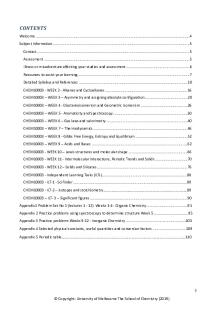Tutorial 6 work PDF

| Title | Tutorial 6 work |
|---|---|
| Course | Introduction To Psychology: Developmental, Social & Clinical Psychology |
| Institution | University of Queensland |
| Pages | 2 |
| File Size | 89.8 KB |
| File Type | |
| Total Downloads | 36 |
| Total Views | 143 |
Summary
Tutorial work - children behavioral inhibition...
Description
1. Identify the PREDICTOR and OUTCOME variable(s) of your lab report study. Predictor variable: non-western children being more inhibited than western children. Outcome variables: latency to touch the sticker on their foreheads on the MSR test. Latency to touch the robot in the behavior inhibition paradigm.
2. Bullet-point what we already know about the variables above based on PREVIOUS FINDINGS presented in your Literature Review paragraphs (i.e., summaries of at least 2 of the 3 journal articles we read as a class). - Non-western children do not perform the same as western children on the MSR test. - Non-western children have more inhibited behavior than western children.
3. Based on the above, what is a GAP in our knowledge or what we still don’t know about the variables? We still do not know why non-western children don’t display the same behavior when performing the MSR test, if it is due to a developmental delay or if it could be related with behavior inhibition.
4. Identify a possible explanation for what we still don’t know or the THEORY for your lab report study (Hint: look back at the “Top Aim” document). This should be framed in light of your responses to Q2 + 3. As behavior inhibition is different stimulated among western and non-western children, this might play a crucial role when children must touch the mark in an unfamiliar situation when facing the mirror in test.
5. Similar to what you did in Activity 1, adapt the following structure to identify the relation(s) between your PREDICTOR and OUTCOME variables: e.g., “Participants who [predictor variable] are more/less/equally likely to [outcome variable] than those who [predictor variable]”. The predicted outcome of the relation (i.e., more/less/equally) should be based on your answers to Q2 + 4 above.
6. Reword what you’ve written in Q5 into a HYPOTHESIS format: “We predicted that…”. Depending on your basic methodology (see “Top Design” document), you may want to further expand your hypothesis to include specific details about each level of the predictor variable: e.g., “Specifically, at [predictor variable]… we expected [predictor variable] to [outcome variable]” etc.
Previous studies argued that if children not touching the mark on the MSR test was due to a developmental delay, then we could identify self-oriented behavior at some point after the hallmark period of 24 months age (Boesch et al.).
which can demonstrate that children not touching the mark on the MSR test are not necessarily lacking self-concept
, while most non-western children from the same age tend not to touch the mark when exposed to the MSR test
These findings represent that cultural variations impact the behavior shown towards the mark on the mirror
may play a crucial role on the likelihood of children’s passing the test Given the MSR test emphasis on touching the mark in an unfamiliar situation to evidence self-recognition, children
Children’s attitudes towards a novel situation can vary among cultures, estern and nonwestern children tend to display different levels of behavior inhibition Children’s., associated with the reluctance to act without a familiar adult’s permission in order to comply with culturally prescribed expectations (Chen et al., 1998)....
Similar Free PDFs

Tutorial 6 work
- 2 Pages

Tutorial work - week 6
- 6 Pages

Tutorial 6 Home Work
- 33 Pages

Tutorial work - 6 - Lab report
- 21 Pages

Tutorial work - week 5 and 6
- 9 Pages

Week Six - Week 6 Tutorial Work
- 1 Pages

Tutorial work - Week 2 - 6, 8 - 13
- 52 Pages

Psych 1x03 - tutorial work
- 1 Pages

CTutorials - tutorial work
- 108 Pages

Tutorial work - Case studies
- 14 Pages

Tutorial work - 12
- 2 Pages

Tutorial work - 1 - 3
- 31 Pages
Popular Institutions
- Tinajero National High School - Annex
- Politeknik Caltex Riau
- Yokohama City University
- SGT University
- University of Al-Qadisiyah
- Divine Word College of Vigan
- Techniek College Rotterdam
- Universidade de Santiago
- Universiti Teknologi MARA Cawangan Johor Kampus Pasir Gudang
- Poltekkes Kemenkes Yogyakarta
- Baguio City National High School
- Colegio san marcos
- preparatoria uno
- Centro de Bachillerato Tecnológico Industrial y de Servicios No. 107
- Dalian Maritime University
- Quang Trung Secondary School
- Colegio Tecnológico en Informática
- Corporación Regional de Educación Superior
- Grupo CEDVA
- Dar Al Uloom University
- Centro de Estudios Preuniversitarios de la Universidad Nacional de Ingeniería
- 上智大学
- Aakash International School, Nuna Majara
- San Felipe Neri Catholic School
- Kang Chiao International School - New Taipei City
- Misamis Occidental National High School
- Institución Educativa Escuela Normal Juan Ladrilleros
- Kolehiyo ng Pantukan
- Batanes State College
- Instituto Continental
- Sekolah Menengah Kejuruan Kesehatan Kaltara (Tarakan)
- Colegio de La Inmaculada Concepcion - Cebu



